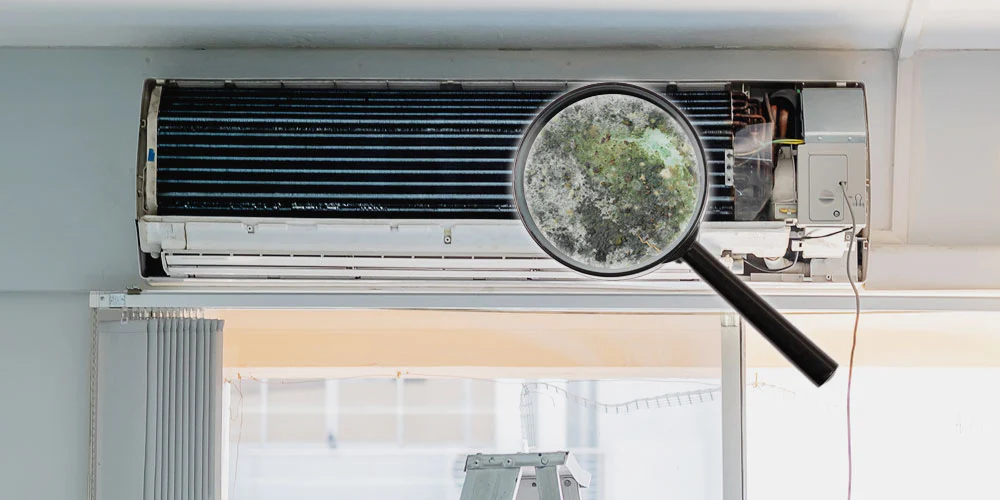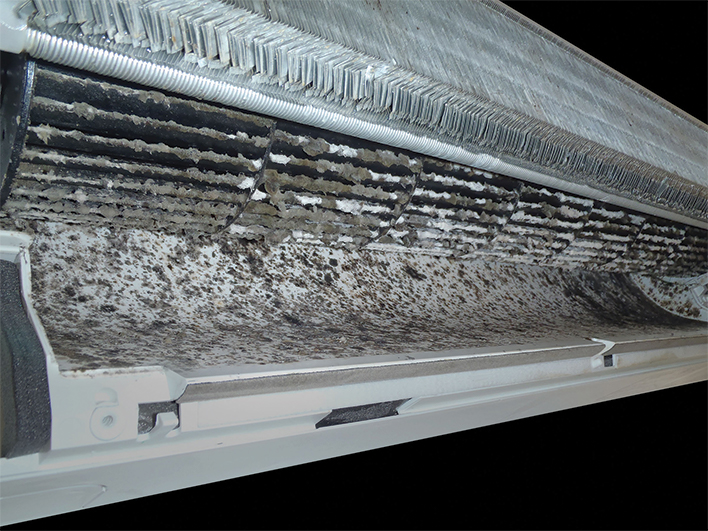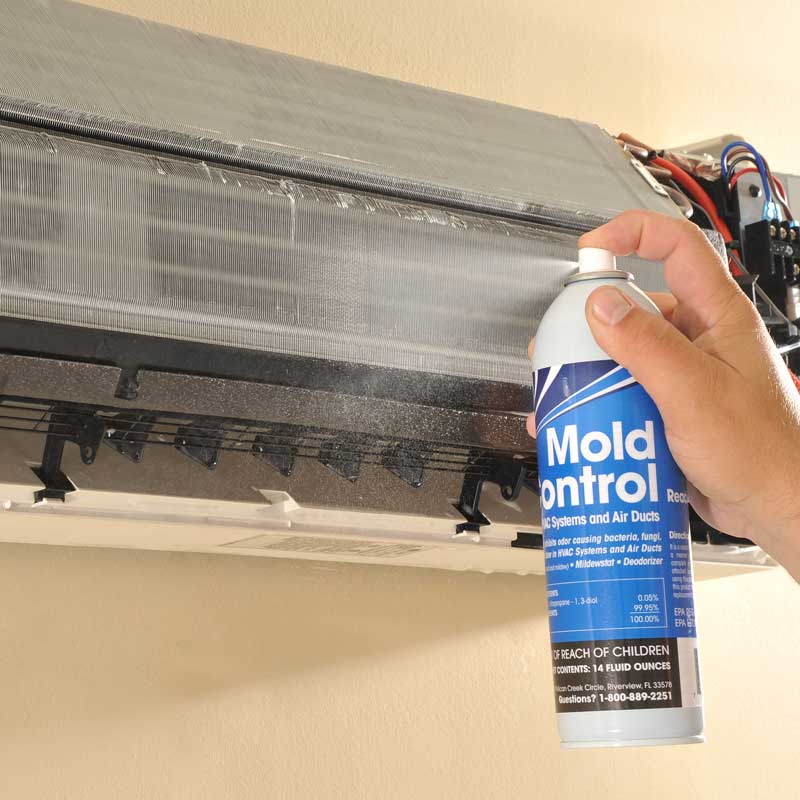
How Does Mold Develop in a Mini Split System?
Mold thrives in damp, dark environments where moisture and organic material are present. Mini split systems, particularly their air handlers, can become ideal environments for mold to grow if moisture builds up and isn’t properly drained. Here are the common causes of mold growth in mini split systems:
1. Moisture Accumulation
Moisture is a key factor in mold development. Mini split systems produce condensation as they cool the air, and if the system’s drainage isn’t working correctly, that moisture can accumulate inside the unit. Over time, this trapped moisture can create the perfect environment for mold spores to thrive, especially if the system is located in a humid climate.
2. Lack of Airflow
Mini split systems rely on good airflow to function properly. If the system’s filters are clogged or the air vents are blocked, the restricted airflow can trap moisture inside the unit, leading to mold growth. Regular maintenance of your mini split system, including cleaning the filters and keeping the area around the unit clear, is essential for preventing mold.
3. Organic Material
Mold needs organic material to grow, and dust and dirt can provide that fuel. If your mini split system is not cleaned regularly, dust and debris can accumulate inside the unit, creating an environment where mold can thrive. This is particularly problematic in rooms like kitchens, where grease and food particles can become airborne and enter the system.
Signs of Mold in a Mini Split System

Identifying mold in your mini split system is crucial for preventing potential health problems and avoiding further damage to your HVAC system. Here are some common signs that mold may be growing inside your mini split:
1. Musty Odor
One of the first signs of mold growth is a musty or mildew-like smell. If you notice this odor when your mini split is running, it’s a strong indicator that mold may be present inside the unit. Mold produces a distinct smell as it grows and releases spores into the air.
2. Visible Mold Growth
In some cases, you may be able to see mold growing on the vents, air filters, or inside the air handler of your mini split system. Look for dark spots, greenish patches, or black mold around the edges of the unit. While visible mold may be easy to spot, mold can also grow in hidden areas, so it’s important to conduct a thorough inspection if you suspect an issue.
3. Allergy or Respiratory Symptoms
Another sign of mold in your mini split system is an increase in allergy or respiratory symptoms when the unit is running. Mold spores can be distributed through the air, leading to symptoms like sneezing, coughing, itchy eyes, and shortness of breath, particularly for individuals with asthma or mold allergies.
How to Remove Mold From a Mini Split System

Once you’ve identified mold in your mini split system, it’s important to take action immediately. Cleaning mold from a mini split system requires the right tools and safety precautions to ensure that the mold is removed properly. Here’s a step-by-step guide to safely removing mold from your mini split:
1. Turn Off and Unplug the System
Before starting any cleaning, make sure to turn off the mini split system and unplug it to avoid electrical hazards. This also prevents the system from circulating mold spores while you’re cleaning.
2. Remove and Clean the Filters
The filters in your mini split system are often the first place mold will develop. Remove the filters and clean them thoroughly using a mixture of water and mild detergent, or a specialized HVAC cleaner. Rinse the filters with clean water and allow them to air dry completely before reinserting them into the system.
3. Clean the Air Handler
The air handler is where mold is most likely to develop. Use a soft brush or cloth to remove any visible mold from the surface, then spray a mold-killing solution, such as a mixture of water and white vinegar or a commercial mold remover, onto the affected areas. Be sure to wipe down all surfaces thoroughly and avoid using bleach, as it can damage the unit and isn’t always effective at killing mold on porous surfaces.
4. Disinfect the Drain Pan and Coils
Mold often grows in the drain pan of mini split systems, where moisture accumulates. Clean the drain pan with a mold-killing solution, and check the condensate drain line to ensure it’s clear of debris. If the drain line is clogged, use a wet/dry vacuum to remove any blockages. Additionally, clean the evaporator coils with an appropriate coil cleaner to prevent mold buildup in this area.
5. Use an Air Purifier
After cleaning the system, running an air purifier in the room can help remove any remaining mold spores from the air. Air purifiers with HEPA filters are especially effective at capturing mold spores and improving indoor air quality.
How to Prevent Mold in a Mini Split System

Now that your mini split system is clean, taking preventive measures can help ensure that mold doesn’t come back. Here are some tips to keep your mini split mold-free:
1. Regular Maintenance
Scheduling regular maintenance for your mini split system is essential for preventing mold growth. Clean or replace the air filters every one to three months, and inspect the system for signs of moisture buildup or dust accumulation. It’s also a good idea to have a professional HVAC technician perform an annual deep cleaning of your system to ensure all components are functioning properly.
2. Control Humidity Levels
Mold thrives in humid environments, so keeping indoor humidity levels below 50% can help prevent mold from growing inside your mini split system. Use a dehumidifier in humid areas, such as basements, and make sure your home is properly ventilated to reduce moisture in the air.
3. Keep the Area Around the Unit Clean
Dirt, dust, and organic material around your mini split can be drawn into the system and provide the perfect conditions for mold growth. Keep the area around the unit clean and free of dust and debris. Additionally, avoid placing furniture or other objects too close to the unit, as this can block airflow and trap moisture.
FAQ
| Question | Answer |
|---|---|
| How do I know if my mini split has mold? | Signs of mold in a mini split include a musty odor, visible mold growth on the unit or filters, and increased allergy or respiratory symptoms when the system is running. |
| Can I clean mold out of my mini split system myself? | Yes, you can clean mold from your mini split system using a mold-killing solution and cleaning the filters, air handler, and drain pan. However, if the mold problem is extensive, you may want to hire a professional for deep cleaning. |
| How often should I clean my mini split system to prevent mold? | To prevent mold, clean or replace the air filters every one to three months, and schedule professional maintenance at least once a year. |
| What’s the best way to prevent mold in a mini split system? | The best way to prevent mold is to keep the system clean, control humidity levels, and ensure proper airflow around the unit. |
| Should I replace my mini split system if it has mold? | If the mold is limited to certain components and can be cleaned, you likely won’t need to replace the system. However, if the mold has caused significant damage or is widespread, replacement may be necessary. |
If you’re dealing with mold in your mini split system or need professional assistance with mold removal, contact Citywide Mold Mitigation for expert services to keep your home mold-free.

